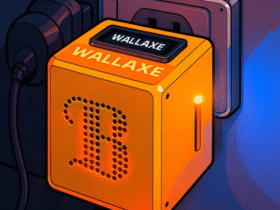As the digital asset industry seeks the next phase of its evolution, one piece of infrastructure has established itself as the fundamental driver of global tokenization. This scenario is precisely where Chainlink projects its next great cycle, since its growth potential depends directly on being the reliable bridge between traditional finance and cryptocurrencies.
The adoption of this infrastructure directly benefits its native token, LINK, as the token is the means of paymentsecurity guarantee and reserve-of-value mechanism of the protocol.
Since its inception, Chainlink’s initial solution was to create decentralized oracle networks to obtain, aggregate and distribute market data across cryptocurrency networks. This proposition quickly made it the dominant oracle provider in the ecosystem, assures Messari, data analysis and research platform.
A report from that firm stands out that, as of early October, Chainlink managed more than $100 billion in DeFi. It also controls 69.9% of the total oracle market.


From price oracle to comprehensive platform
However, the ultimate goal of the network “was never simply to deliver data to other networks,” Messari says. As the industry evolved from single-chain applications to a fragmented multi-chain landscape with tokenized real-world assets (RWAs) and institutional solutions, the requirements to unlock value on-chain expanded.
This transition evolved from simple feeds from pricing to advanced data orchestrationregulatory compliance, privacy, cross-chain execution and financial integration. «Chainlink’s response was clear. “It evolved to become a comprehensive platform for on-chain finance,” they argue from Messari.
The chart below illustrates the explosive growth of RWA as a reflection of Chainlink’s growth potential. The total value growth of that market reached $322 billion as of October 1, 2025, an increase of 47% so far this year, with stablecoins representing the majority of this value.


Currently, tokenized RWAs require data standards, interoperability, compliance and privacy, requirements that are provided by the Chainlink infrastructure, Messari explains.
In fact, many of the largest RWA initiatives, such as Ondo and xStocks, already rely on Chainlink to ensure data and asset integrity. According to Messari, “the deepening adoption of standardized infrastructures like Chainlink is inevitable as institutional participation in tokenized markets intensifies.”
The Chainlink Reserve
This broader reach also redefines the role of LINK, the network token. Launched in 2017, currently serves as a payment unit for oracle services, staking, and node incentives. LINK’s circulating market capitalization and price show an increase of 10.4% and 3.9%, respectively, so far this year.


Over time, Chainlink’s security model has been consolidated, evolving along with new monetization and value capture mechanisms, Messari details.
Along these lines, last August, Chainlink announced the creation of the Chainlink Reserve, a LINK on-chain reserve funded by both on-chain service fees and off-chain business revenue. Since its launch, the reserve has accumulated more than 9 million dollars in LINKand is expected to grow as its adoption in capital markets and enterprise integrations spreads, says Messari.
This strategic mechanism automatically converts revenue generated by the Chainlink network itself, whether in ether (ETH), USDC or other assets, into LINK tokens purchased on the market. These tokens go into a long-term growth treasury.
Messari notes that “this virtuous cycle of adoption and revenue is critical to the sustainability and long-term growth of LINK’s value, aligning the network’s incentives with the success of its platform.”
The Chainlink Expansion Framework
Additionally, Chainlink launched the Chainlink Rewards community engagement program. This allows projects in Chainlink Build make its native tokens claimable by participants in the Chainlink ecosystem, including participants who are staking eligible LINK.
The Build program supports emerging and established projects within the ecosystem, providing them with greater access to Chainlink services and technical support.
Chainlink has evolved into a multi-standard infrastructure with five key categories: data, interoperability, regulatory compliance, privacy and orchestration, the Messari report details.
Market demand now ranges from high-frequency price streaming to institutionally compliant fund management. Chainlink’s infrastructure and presence covers the entire spectrum of on-chain finance.
To date, the network has facilitated transactions worth more than $26 trillion, integrated more than 2,400 projects, and operates more than 2,000 decentralized oracle networks (DONs), the research firm says.
Chainlink’s nexus with traditional finance
In the traditional finance (TradFi) space, Chainlink provides the connectivity infrastructure for financial markets, fund managers, banks and asset managers looking to integrate regulated products on the blockchain.
Its strategic alliances in TradFi include: JP Morgan (Kinexys), UBS, Swift, Mastercard, Fidelity International, and WisdomTree, highlights Messari.
Chainlink facilitates cross-chain settlement of assets with banks such as JP Morgan and UBS. It also allows institutions to connect to public or private networks using Swift. These integrations highlight its function as a link between fragmented systems.
On the DeFi side, Chainlink is integrated into lending, derivatives and tokenized asset platforms like AaveLido, Securitize, Spiko Finance, and ether.fi.
Chainlink standards and services enable regulatory compliance, reporting and cross-chain operations, connecting financial institutions to any network with their existing messaging standards, Messari mentions.
In DeFi, Chainlink underpins lending platforms like Aave and Kamino with secure data, powers liquid cross-chain staking with Lido, enables distribution of tokenized stocks with xStocks, and supports money market funds through Spiko.
Chainlink’s growth potential
Looking ahead, the trajectory points to Chainlink as the comprehensive platform for on-chain finance. By combining data, compliance, programmability, interoperability and privacy into a single orchestration layer, Chainlink positions itself as the infrastructure that underpins stablecoins, tokenized funds, and other financial applications that require a verifiable, compliant and interoperable infrastructure, Messari asserts.
This panorama is reinforced by significant external movements. As reported by CriptoNoticias, Grayscale filed an S-1 form in September to launch the first LINK-based exchange-traded fund (ETF) with staking.
Grayscale’s proposal is a development that underlines institutional recognition of its value and, above all, Chainlink’s enormous growth potential in the global financial ecosystem.
Thanks to its leadership among oracles, the on-chain reserve, alliances with JP Morgan, Swift and Mastercard, and the explosion of tokenized RWAs, Chainlink’s growth potential—in the opinion of Messari analysts—remains one of the most attractive in the sector for the coming years.






Leave a Reply